Abstract
The ultrastructural localization of the CD68 antigen, a 110-kd intracellular glycoprotein associated with myeloid cells and with monocytes/macrophages, was investigated in human neutrophil granulocytes by postembedding immunogold staining, using monoclonal antibody KP1. The antigen was found in the primary granules of neutrophils, although not all primary granules were labeled. It was absent from the plasma membrane. In monocytes, it was also detected within cytoplasmic granules, colocalized with lysozyme and myeloperoxidase. This observation confirms and completes results obtained by immunofluorescence and other light-microscopic methods. Moreover this study shows that the CD68 epitope recognized by antibody KP1 is able to resist fixation and embedment and therefore emphasizes the value of using KP1 as a marker for this macrophage-associated molecule.
Full text
PDF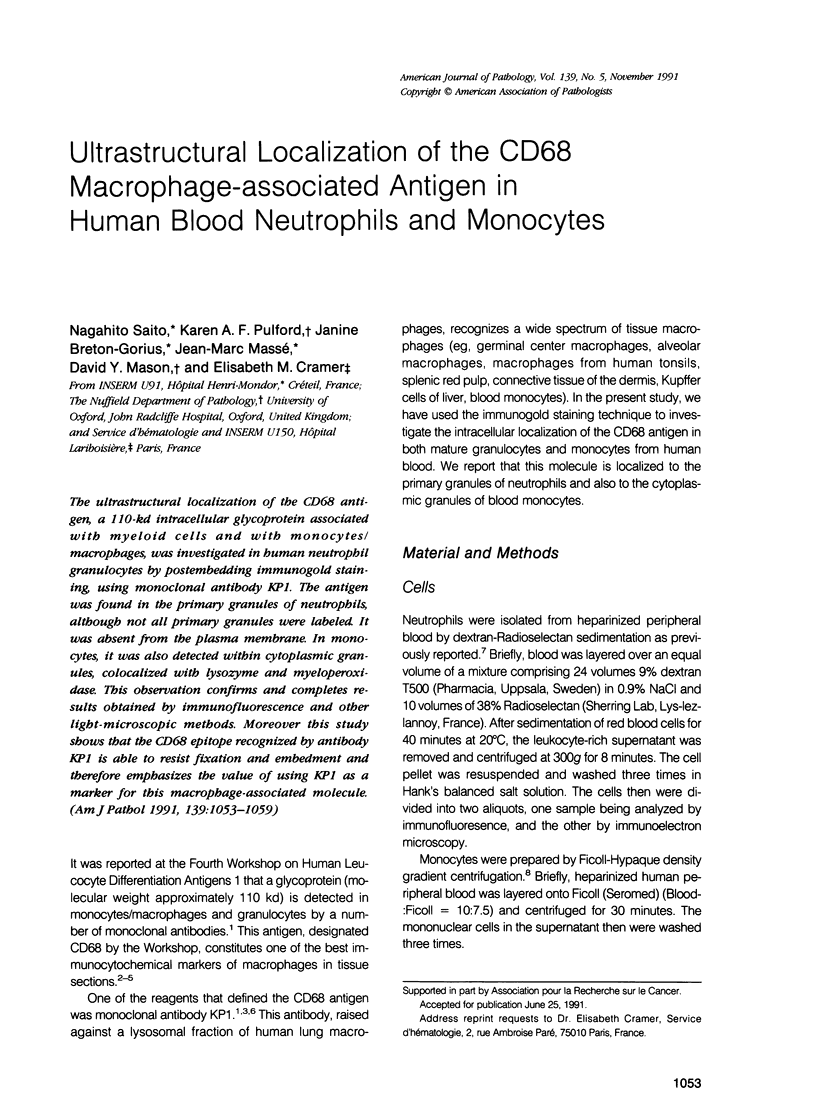
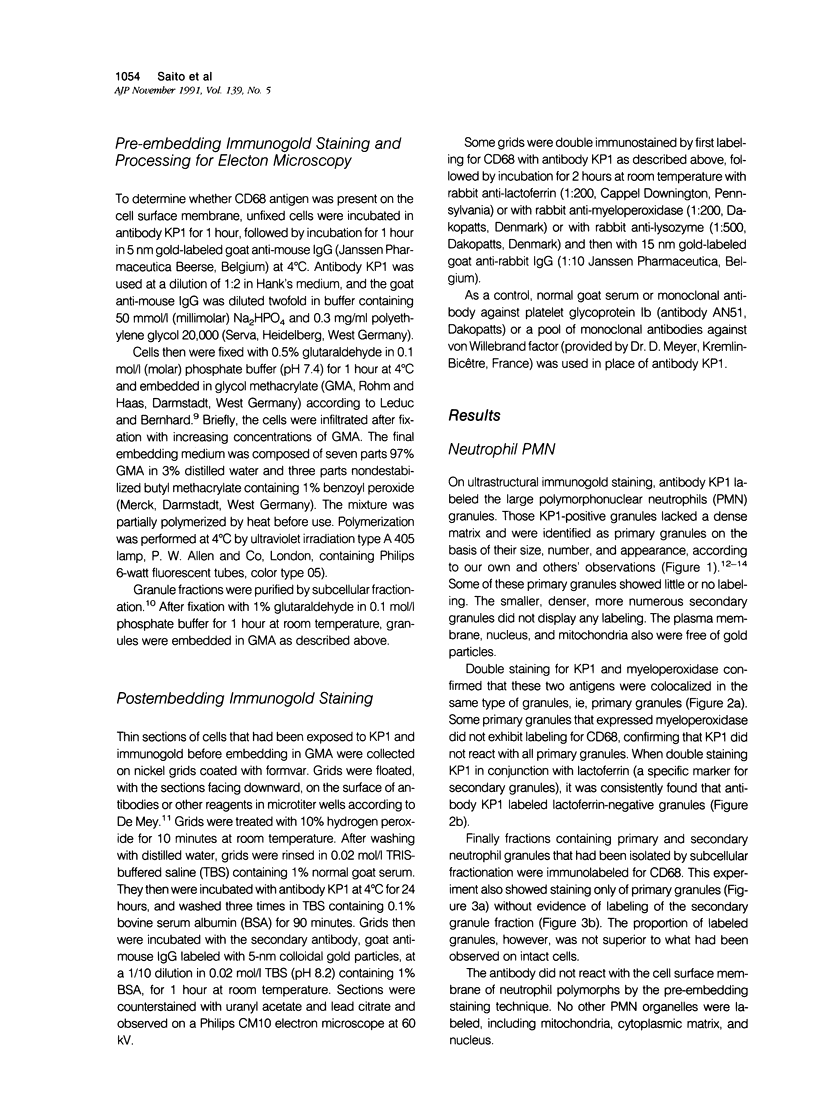
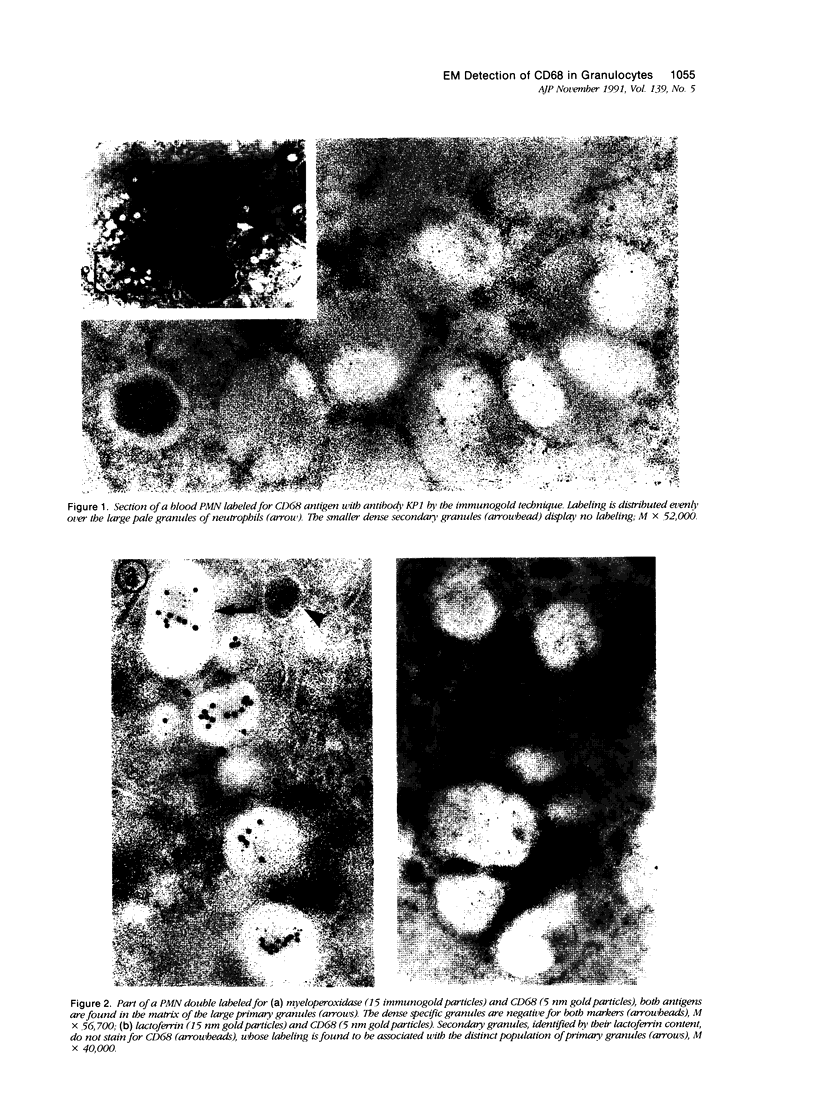
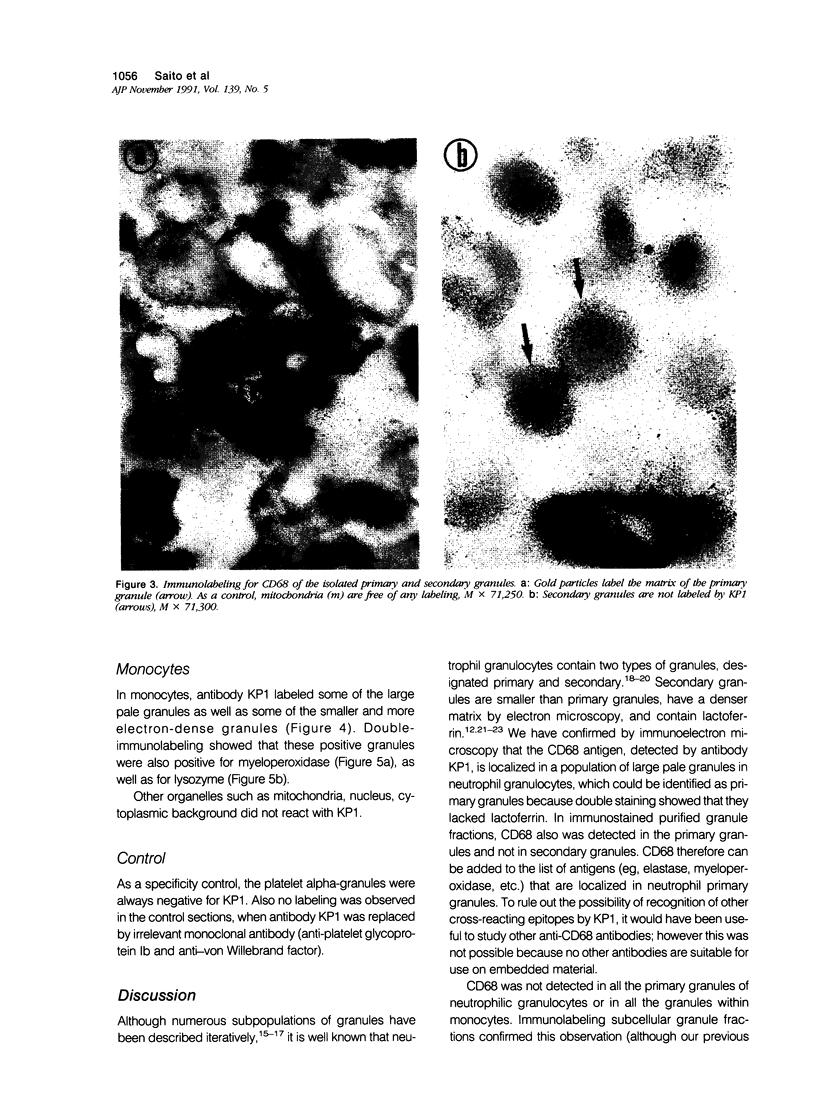
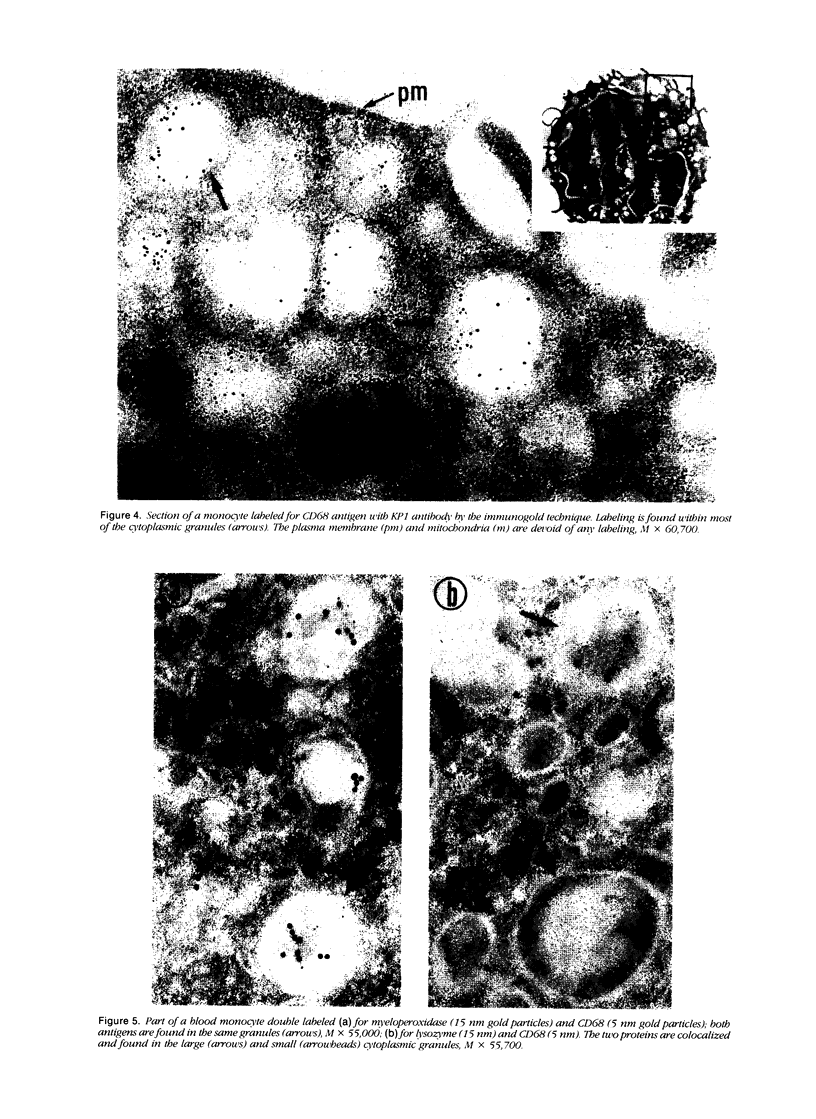
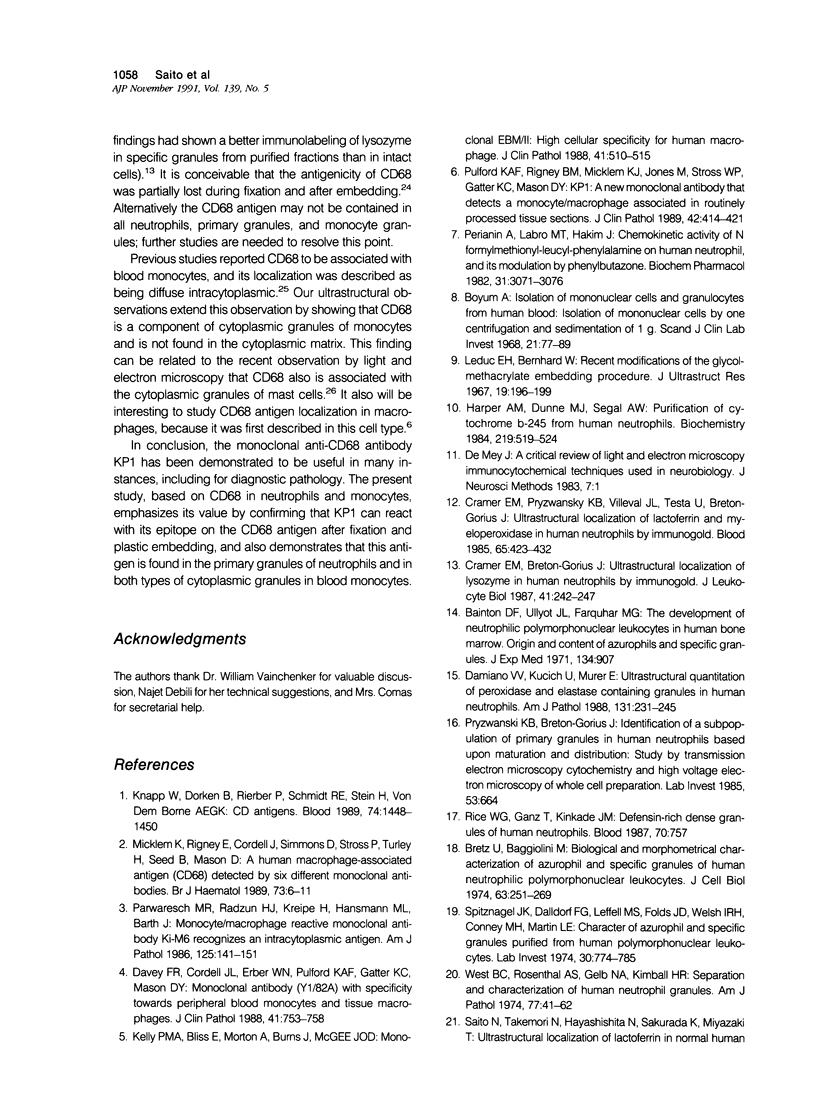
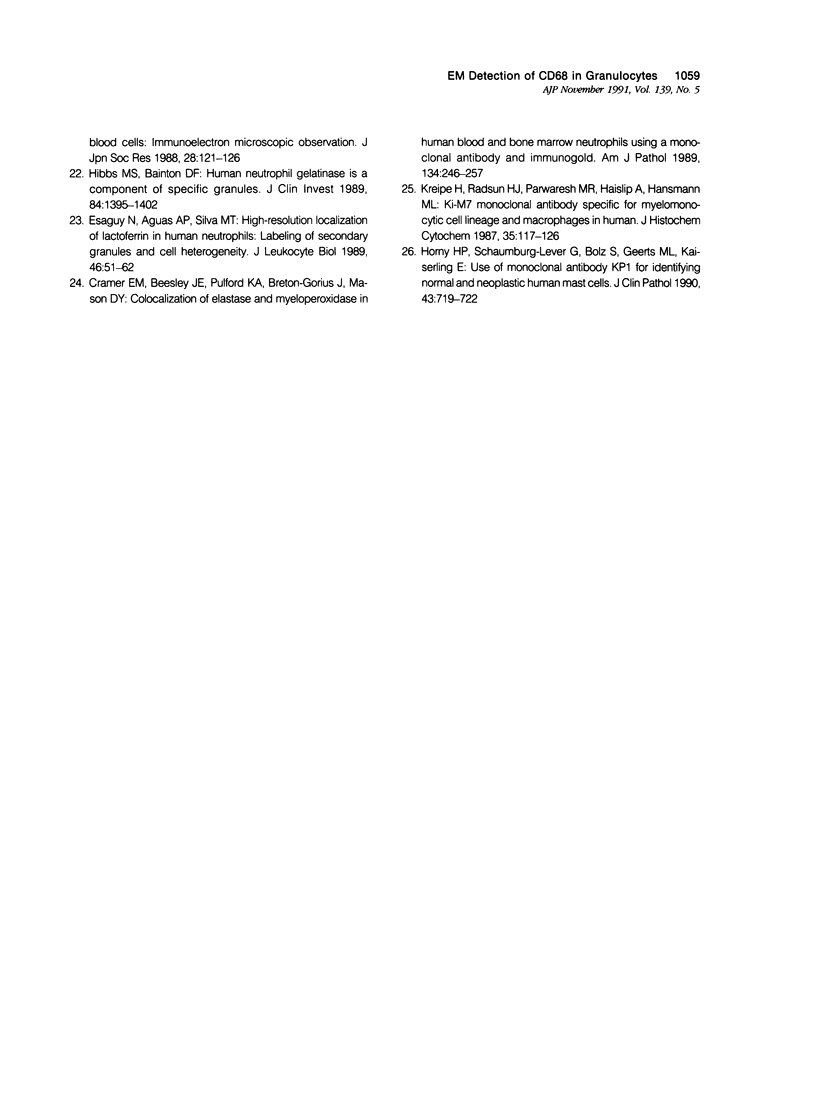
Images in this article
Selected References
These references are in PubMed. This may not be the complete list of references from this article.
- Bainton D. F., Ullyot J. L., Farquhar M. G. The development of neutrophilic polymorphonuclear leukocytes in human bone marrow. J Exp Med. 1971 Oct 1;134(4):907–934. doi: 10.1084/jem.134.4.907. [DOI] [PMC free article] [PubMed] [Google Scholar]
- Bretz U., Baggiolini M. Biochemical and morphological characterization of azurophil and specific granules of human neutrophilic polymorphonuclear leukocytes. J Cell Biol. 1974 Oct;63(1):251–269. doi: 10.1083/jcb.63.1.251. [DOI] [PMC free article] [PubMed] [Google Scholar]
- Böyum A. Isolation of mononuclear cells and granulocytes from human blood. Isolation of monuclear cells by one centrifugation, and of granulocytes by combining centrifugation and sedimentation at 1 g. Scand J Clin Lab Invest Suppl. 1968;97:77–89. [PubMed] [Google Scholar]
- Cramer E. M., Breton-Gorius J. Ultrastructural localization of lysozyme in human neutrophils by immunogold. J Leukoc Biol. 1987 Mar;41(3):242–247. doi: 10.1002/jlb.41.3.242. [DOI] [PubMed] [Google Scholar]
- Cramer E., Pryzwansky K. B., Villeval J. L., Testa U., Breton-Gorius J. Ultrastructural localization of lactoferrin and myeloperoxidase in human neutrophils by immunogold. Blood. 1985 Feb;65(2):423–432. [PubMed] [Google Scholar]
- Damiano V. V., Kucich U., Murer E., Laudenslager N., Weinbaum G. Ultrastructural quantitation of peroxidase- and elastase-containing granules in human neutrophils. Am J Pathol. 1988 May;131(2):235–245. [PMC free article] [PubMed] [Google Scholar]
- Davey F. R., Cordell J. L., Erber W. N., Pulford K. A., Gatter K. C., Mason D. Y. Monoclonal antibody (Y1/82A) with specificity towards peripheral blood monocytes and tissue macrophages. J Clin Pathol. 1988 Jul;41(7):753–758. doi: 10.1136/jcp.41.7.753. [DOI] [PMC free article] [PubMed] [Google Scholar]
- De Mey J. A critical review of light and electron microscopic immunocytochemical techniques used in neurobiology. J Neurosci Methods. 1983 Jan;7(1):1–18. doi: 10.1016/0165-0270(83)90014-6. [DOI] [PubMed] [Google Scholar]
- Esaguy N., Aguas A. P., Silva M. T. High-resolution localization of lactoferrin in human neutrophils: labeling of secondary granules and cell heterogeneity. J Leukoc Biol. 1989 Jul;46(1):51–62. doi: 10.1002/jlb.46.1.51. [DOI] [PubMed] [Google Scholar]
- Harper A. M., Dunne M. J., Segal A. W. Purification of cytochrome b-245 from human neutrophils. Biochem J. 1984 Apr 15;219(2):519–527. doi: 10.1042/bj2190519. [DOI] [PMC free article] [PubMed] [Google Scholar]
- Hibbs M. S., Bainton D. F. Human neutrophil gelatinase is a component of specific granules. J Clin Invest. 1989 Nov;84(5):1395–1402. doi: 10.1172/JCI114312. [DOI] [PMC free article] [PubMed] [Google Scholar]
- Horny H. P., Schaumburg-Lever G., Bolz S., Geerts M. L., Kaiserling E. Use of monoclonal antibody KP1 for identifying normal and neoplastic human mast cells. J Clin Pathol. 1990 Sep;43(9):719–722. doi: 10.1136/jcp.43.9.719. [DOI] [PMC free article] [PubMed] [Google Scholar]
- Kelly P. M., Bliss E., Morton J. A., Burns J., McGee J. O. Monoclonal antibody EBM/11: high cellular specificity for human macrophages. J Clin Pathol. 1988 May;41(5):510–515. doi: 10.1136/jcp.41.5.510. [DOI] [PMC free article] [PubMed] [Google Scholar]
- Knapp W., Dörken B., Rieber P., Schmidt R. E., Stein H., von dem Borne A. E. CD antigens 1989. Blood. 1989 Sep;74(4):1448–1450. [PubMed] [Google Scholar]
- Leduc E. H., Bernhard W. Recent modifications of the glycol methacrylate embedding procedure. J Ultrastruct Res. 1967 Jul;19(1):196–199. doi: 10.1016/s0022-5320(67)80068-6. [DOI] [PubMed] [Google Scholar]
- Micklem K., Rigney E., Cordell J., Simmons D., Stross P., Turley H., Seed B., Mason D. A human macrophage-associated antigen (CD68) detected by six different monoclonal antibodies. Br J Haematol. 1989 Sep;73(1):6–11. doi: 10.1111/j.1365-2141.1989.tb00210.x. [DOI] [PubMed] [Google Scholar]
- Parwaresch M. R., Radzun H. J., Kreipe H., Hansmann M. L., Barth J. Monocyte/macrophage-reactive monoclonal antibody Ki-M6 recognizes an intracytoplasmic antigen. Am J Pathol. 1986 Oct;125(1):141–151. [PMC free article] [PubMed] [Google Scholar]
- Perianin A., Labro M. T., Hakim J. Chemokinetic activity of N-formyl-methionyl-leucyl-phenylalanine on human neutrophils, and its modulation by phenylbutazone. Biochem Pharmacol. 1982 Oct 1;31(19):3071–3076. doi: 10.1016/0006-2952(82)90082-x. [DOI] [PubMed] [Google Scholar]
- Pryzwansky K. B., Breton-Gorius J. Identification of a subpopulation of primary granules in human neutrophils based upon maturation and distribution. Study by transmission electron microscopy cytochemistry and high voltage electron microscopy of whole cell preparations. Lab Invest. 1985 Dec;53(6):664–671. [PubMed] [Google Scholar]
- Pulford K. A., Rigney E. M., Micklem K. J., Jones M., Stross W. P., Gatter K. C., Mason D. Y. KP1: a new monoclonal antibody that detects a monocyte/macrophage associated antigen in routinely processed tissue sections. J Clin Pathol. 1989 Apr;42(4):414–421. doi: 10.1136/jcp.42.4.414. [DOI] [PMC free article] [PubMed] [Google Scholar]
- Rice W. G., Ganz T., Kinkade J. M., Jr, Selsted M. E., Lehrer R. I., Parmley R. T. Defensin-rich dense granules of human neutrophils. Blood. 1987 Sep;70(3):757–765. [PubMed] [Google Scholar]
- Spitznagel J. K., Dalldorf F. G., Leffell M. S., Folds J. D., Welsh I. R., Cooney M. H., Martin L. E. Character of azurophil and specific granules purified from human polymorphonuclear leukocytes. Lab Invest. 1974 Jun;30(6):774–785. [PubMed] [Google Scholar]
- West B. C., Rosenthal A. S., Gelb N. A., Kimball H. R. Separation and characterization of human neutrophil granules. Am J Pathol. 1974 Oct;77(1):41–66. [PMC free article] [PubMed] [Google Scholar]







